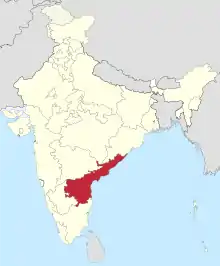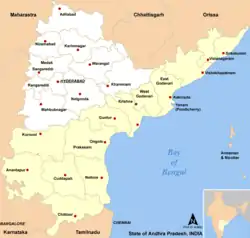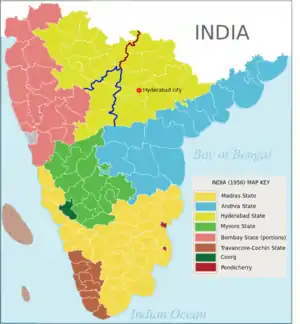Andhra State
Andhra State (IAST: Āndhra Stēt) (IPA: [ˈɑːndʰrʌ steɪt]) was a state in India created 1953, from the Telugu-speaking northern districts of Madras State.[1] The state was made up of this two distinct cultural regions – Rayalaseema and Coastal Andhra. Andhra State was created in 1953 but it excluded a few Telugu-speaking areas in Hyderabad State. Andhra Pradesh became the first state in India constituted under the State Reorganisation Act of 1956.
| Andhra State | |||||||||
|---|---|---|---|---|---|---|---|---|---|
| Former State of India | |||||||||
| 1953–1956 | |||||||||
 Andhra State | |||||||||
| Capital | Kurnool | ||||||||
| Government | |||||||||
| • Type | Federated state | ||||||||
| Governor | |||||||||
• 1953-1956 | Chandulal Madhavlal Trivedi | ||||||||
| History | |||||||||
• Established | 1953 | ||||||||
| 1 November 1956 | |||||||||
| |||||||||
Creation of Andhra State

In an effort to protect the interests of the Telugu people of Madras State, Potti Sreeramulu attempted to force the Madras state government to listen to public demands for the separation of Telugu-speaking districts (Rayalaseema and Coastal Andhra) from Madras State to form Andhra State. He went on a lengthy fast and only stopped when Prime Minister Jawaharlal Nehru promised to form Andhra State. However, there was no movement on the issue for a long time. He started fasting again in Maharshi Bulusu Sambamurti's house in Madras on 19 October 1952. It started off without fanfare but steadily caught people's attention despite the disapproval of the fast by the Andhra INC committee.
The government of the day, however, did not make a clear statement about the formation of a new state, despite several strikes and demonstrations by Telugu people. On the midnight of 15 December (i.e. early 16 December 1952), Sreeramulu died trying to achieve his objective at House No. 126, Royapethah High Road, Mylapore, Madras State; the house has been preserved as a monument by the state government.[2]
In his death procession, people shouted slogans praising his sacrifice. When the procession reached Mount Road, thousands of people joined and raised slogans hailing Sreeramulu. Later, they went into a frenzy and resorted to the destruction of public property. The news spread like wildfire and created an uproar among the people in far off places like Chirala, Vizianagaram, Visakhapatnam, Vijayawada, Rajahmundry, Eluru, Bhimavaram, Guntur, Tenali, Ongole and Nellore. Seven people were killed in clashes with police in Anakapalle and Vijayawada. The popular agitation continued for three to four days disrupting normal life in Madras and Andhra regions. On 19 December 1952, the Prime Minister of the country Jawaharlal Nehru made an announcement about the formation of a separate state for the Telugu-speaking people of Madras State. The central government appointed K. N. Wanchoo, Chief Justice of the Rajasthan High Court,[3] to look into issues related to formation of Andhra State. Parliament passed the Andhra State Act in September 1953.[4]
On 1 October 1953, 11 districts in the Telugu-speaking portion of Madras State became the new Andhra State with Kurnool as the capital. Tanguturi Prakasam Pantulu (also known as Andhra Kesari – "The Lion of Andhra") became the first Chief Minister of the new state.[5]
Formation of this first "linguistic state" paved the way to creation of more and provided an opportunity for these states to develop independently, linguistically and economically, each of them having a state to support.[6][7]
Districts of Andhra State

- Vizianagaram district was created out of parts of Visakhapatnam district and Srikakulam district in 1979.
- Prakasam district was created out of parts of Guntur district, Nellore district and Kurnool district in 1970.
Bhadrachalam and Nuguru Venkatapuram taluks of East Godavari (part of coastal Andhra Pradesh), which are on the other side of the river Godavari, were merged into Khammam district on grounds of geographical contiguity and administrative viability. Earlier, Aswaraopeta was also part of West Godavari district and was added to Khammam district in 1959. Similarly, Munagala mandal was added to Nalgonda district and removed from Krishna district in 1959.
Formation of Andhra Pradesh of new

On 1 November 1956 Andhra State and the Telangana region of Hyderabad State were merged to form the united Telugu-speaking State of Andhra Pradesh. Non-Telugu-speaking parts of Hyderabad State were merged with Bombay State and Karnataka State.

After a reorganization in 1956, regions of the state west of the red and blue lines merged with Bombay and Mysore States, respectively, and the rest of the state (Telangana) was merged with Andhra State to form Andhra Pradesh State.
SRC (Fazal Ali Commission)
Paragraph 382 of the SRC report dated 30 September 1955 said, "opinion in Andhra is overwhelmingly in favour of the larger unit, public opinion in Telangana has still to crystallize itself. Important leaders of public opinion in Andhra themselves seem to appreciate that the unification of Telangana with Andhra, though desirable, should be based on a voluntary and willing association of the people and that it is primarily for the people of Telangana to make a decision about their future".
While the Fazal Ali commission emphasizes the necessity and benefits Visalandhra, the report suggests that the process of merging may only be done after 5 years. In Paragraph 386, it states, "...for the present the Telangana area is to constitute into a separate State, which may be known as Hyderabad State with provision for its unification with Andhra after the general elections likely to be held in or about 1961 if by a two-thirds majority the legislature of the residency Hyderabad State expresses itself in favor of such unification".
Paragraph 387 goes on to say that the advantage of this arrangement will be that while the objective of the unification of the Andhras will neither be blurred nor impeded during a period of five or six years, the two governments may have stabilized their administrative machinery and, if possible, also reviewed their land revenue systems, etc., the object in view being the attainment of uniformity. The intervening period may incidentally provide an opportunity for allaying apprehensions and achieving the consensus of opinion necessary for a real union between the two States.[8]
From the content of Paragraph 387, the commission's main objective was to attain uniformity by achieving adequate administrative machinery and proper land review systems in the recently formed Andhra State and the new State of Hyderabad being formed and this duration could also be incidentally utilized for gaining consensus opinion for the merger of the two states. In line with SRC opinion, the elected leaders of both states decided for an immediate merger by achieving consensus by two-thirds majority strength in both assemblies of these states.
The Hyderabad chief minister, in his letter to the INC president, said Communist parties supported the merger for their political calculations. The Hyderabad PCC chief said the overwhelming majority of INC party members opposed the merger, that Communists were elected in special circumstances in 1951, that Visalandhra was not a political issue in 1951, and that the Assembly does not reflect the people's view on the issue. He also said 80% of INC delegates who were elected in 1955 opposed the merger. The government had to provide additional security for Communist leaders who supported the Visalandhra.[9]
In the Hyderabad Assembly, on 3 December 1955, 147 of 174 MLAs expressed their view. 103 (including Marathi and Kannada MLAs) supported the merger, 16 were neutral, and 29 opposed it. Among Telangana MLAs, 59 supported the merger and 25 opposed it. Out of 94 Telangana MLAs in the assembly, 36 were Communists (PDF), 40 were INC, 11 were Socialist party (SP), and 9 were independents. Voting did not take place on the resolution because Telangana proponents insisted on including the phrase "As per the wishes of people" in the resolution.[10][11]
To convince the leadership of Telangana to join the new state, an agreement was reached between the leaders of both sides. This came to be known as the Gentlemen's agreement. The agreement allowed the formation of the State of Andhra Pradesh in 1956, against the SRC's recommendations of waiting until 1961 to get the approval of 2/3 of Telangana State assembly after the 2 cycles of elections in Telangana State.
Telangana and 1972 Jai Andhra movements
The Telangana movement was started in 1969, demanding proper implementation of the Gentlemen's agreement, particularly the mulki rules. When the Supreme Court upheld the discriminatory mulki rules applicable among the people of a state, it spawned the 1972 Jai Andhra movement. This was a public agitation demanding a separate Andhra State. The movement dissipated after the central government repealed the mulki rules and introduced a new six-point formula.
Creation of Telangana State
On 2 June 2014, Telangana State was separated back out of Andhra Pradesh and Kalvakuntla Chandrashekhar Rao better known and abbreviated as K.C.R. is the 1st and the current Chief Minister of Telangana after the Telangana state got separated from United Andhra Pradesh.
See also
References
- "Map of Madras Presidency in 1909". Retrieved 15 October 2013.
- Ramachandra Guha. India After Gandhi: The History of the World's Largest Democracy Harper Perennial; Reprint edition (12 August 2008) ISBN 0-06-095858-8 ISBN 978-0330505543
- Kumar, Virendra (1 January 1976). Committees and Commissions in India Vol. 1 : 1947-54. ISBN 9788170221968.
- "THE ANDHRA STATE ACT,1953". Retrieved 26 August 2013.
- "Indian Express October 2, 1953". Retrieved 26 August 2013.
- "Archived copy". Archived from the original on 5 July 2008. Retrieved 13 December 2011.CS1 maint: archived copy as title (link)
- http://www.sankalpindia.net/drupal/the-first-linguistic-state-andhra-pradesh-was-born
- s:India States Reorganisation Commission Report Telangana Andhra#The Case for Telangana
- "No belief in Safeguards: Hyderabad PCC chief. - Page 4 of Nov 21, 1955 Indian Express". 21 November 1955. Retrieved 9 October 2011.
- "Page 1 of the edition December 5, 1955" (PDF). Andhra Prabha dated 5 December 1955. Archived from the original (PDF) on 16 October 2013. Retrieved 15 August 2013.
- "STATISTICAL REPORT ON GENERAL ELECTION, 1951 TO THE LEGISLATIVE ASSEMBLY OF HYDERABAD" (PDF). Election Commission. Retrieved 15 August 2013.